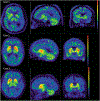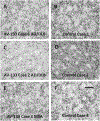Clinicopathological Correlation: Dopamine and Amyloid PET Imaging with Neuropathology in Three Subjects Clinically Diagnosed with Alzheimer's Disease or Dementia with Lewy Bodies
- PMID: 33720879
- PMCID: PMC10109539
- DOI: 10.3233/JAD-200323
Clinicopathological Correlation: Dopamine and Amyloid PET Imaging with Neuropathology in Three Subjects Clinically Diagnosed with Alzheimer's Disease or Dementia with Lewy Bodies
Abstract
Background: Imaging biomarkers have the potential to distinguish between different brain pathologies based on the type of ligand used with PET. AV-45 PET (florbetapir, Amyvid™) is selective for the neuritic plaque amyloid of Alzheimer's disease (AD), while AV-133 PET (florbenazine) is selective for VMAT2, which is a dopaminergic marker.
Objective: To report the clinical, AV-133 PET, AV-45 PET, and neuropathological findings of three clinically diagnosed dementia patients who were part of the Avid Radiopharmaceuticals AV133-B03 study as well as the Arizona Study of Aging and Neurodegenerative Disorders (AZSAND).
Methods: Three subjects who had PET imaging with both AV-133 and AV-45 as well as a standardized neuropathological assessment were included. The final clinical, PET scan, and neuropathological diagnoses were compared.
Results: The clinical and neuropathological diagnoses were made blinded to PET scan results. The first subject had a clinical diagnosis of dementia with Lewy bodies (DLB); AV-133 PET showed bilateral striatal dopaminergic degeneration, and AV-45 PET was positive for amyloid. The final clinicopathological diagnosis was DLB and AD. The second subject was diagnosed clinically with probable AD; AV-45 PET was positive for amyloid, while striatal AV-133 PET was normal. The final clinicopathological diagnosis was DLB and AD. The third subject had a clinical diagnosis of DLB. Her AV-45 PET was positive for amyloid and striatal AV-133 showed dopaminergic degeneration. The final clinicopathological diagnosis was multiple system atrophy and AD.
Conclusion: PET imaging using AV-133 for the assessment of striatal VMAT2 density may help distinguish between AD and DLB. However, some cases of DLB with less-pronounced nigrostriatal dopaminergic neuronal loss may be missed.
Keywords: AV-133; Alzheimer’s disease; VMAT2; amyloid; dementia with Lewy bodies; synucleinopathy.
Figures



Similar articles
-
PET imaging of amyloid with Florbetapir F 18 and PET imaging of dopamine degeneration with 18F-AV-133 (florbenazine) in patients with Alzheimer's disease and Lewy body disorders.BMC Neurol. 2014 Apr 9;14:79. doi: 10.1186/1471-2377-14-79. BMC Neurol. 2014. PMID: 24716655 Free PMC article.
-
Differential diagnosis in Alzheimer's disease and dementia with Lewy bodies via VMAT2 and amyloid imaging.Neurodegener Dis. 2012;10(1-4):161-5. doi: 10.1159/000334535. Epub 2012 Jan 17. Neurodegener Dis. 2012. PMID: 22261520
-
AV-1451 tau and β-amyloid positron emission tomography imaging in dementia with Lewy bodies.Ann Neurol. 2017 Jan;81(1):58-67. doi: 10.1002/ana.24825. Epub 2016 Dec 19. Ann Neurol. 2017. PMID: 27863444 Free PMC article.
-
Florbetapir (18F), a PET imaging agent that binds to amyloid plaques for the potential detection of Alzheimer's disease.IDrugs. 2010 Dec;13(12):890-9. IDrugs. 2010. PMID: 21154149 Review.
-
Imaging β-amyloid using [(18)F]flutemetamol positron emission tomography: from dosimetry to clinical diagnosis.Eur J Nucl Med Mol Imaging. 2016 Feb;43(2):362-373. doi: 10.1007/s00259-015-3208-1. Epub 2015 Oct 6. Eur J Nucl Med Mol Imaging. 2016. PMID: 26440450 Review.
Cited by
-
A Novel and Selective Dopamine Transporter Inhibitor, (S)-MK-26, Promotes Hippocampal Synaptic Plasticity and Restores Effort-Related Motivational Dysfunctions.Biomolecules. 2022 Jun 24;12(7):881. doi: 10.3390/biom12070881. Biomolecules. 2022. PMID: 35883437 Free PMC article.
-
Nigrostriatal dopaminergic neurotransmission and resilience to peripheral systemic risk factors for gait slowing upon transition to uneven surfaces in older adult.Aging Brain. 2025 Jun 20;8:100143. doi: 10.1016/j.nbas.2025.100143. eCollection 2025. Aging Brain. 2025. PMID: 40606490 Free PMC article.
References
-
- Villemagne VL, Okamura N, Pejoska S, Drago J, Mulligan RS, Chetelat G, O’Keefe G, Jones G, Kung HF, Pontecorvo M, Masters CL, Skovronsky DM, Rowe CC (2012) Differential diagnosis in Alzheimer’s disease and dementia with Lewy bodies via VMAT2 and amyloid imaging. Neurodegener Dis 10, 161–165. - PubMed
Publication types
MeSH terms
Substances
Grants and funding
LinkOut - more resources
Full Text Sources
Other Literature Sources
Medical

